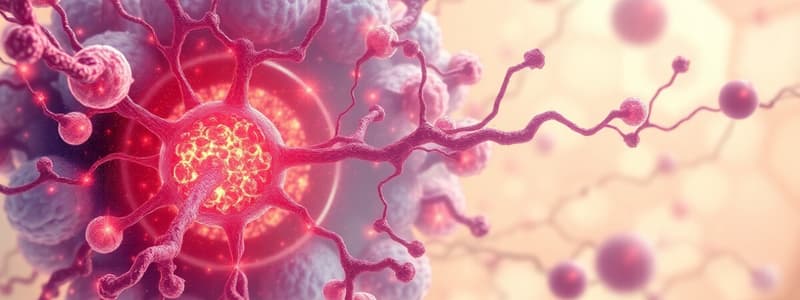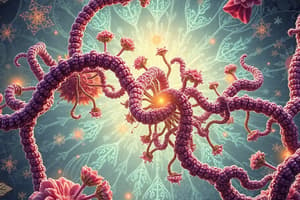Podcast
Questions and Answers
What is the function of a ligand in the context of pharmacodynamics?
What is the function of a ligand in the context of pharmacodynamics?
- To deactivate the receptors completely
- To alter the shape of receptors (correct)
- To create a maximum response of 100% Emax
- To bind exclusively to antagonists
Which of the following accurately describes an antagonist?
Which of the following accurately describes an antagonist?
- A medication that mimics the ligand's action
- A medication that binds to a receptor but activates it
- A medication that enhances the receptor's response
- A medication that prevents receptor activation by other agonists (correct)
What does Emax represent in pharmacodynamics?
What does Emax represent in pharmacodynamics?
- The concentration at which a medication is toxic
- The maximum effect an agonist can achieve (correct)
- The minimum dose required for a response
- The degradation rate of a medication
What effect does a partial agonist have when administered with a full agonist?
What effect does a partial agonist have when administered with a full agonist?
How does increasing the dose of a full agonist affect the dose-response curve when a partial agonist is present?
How does increasing the dose of a full agonist affect the dose-response curve when a partial agonist is present?
What determines the intrinsic activity of an agonist?
What determines the intrinsic activity of an agonist?
In a dose-response relationship, what does an increase in agonist dose primarily affect?
In a dose-response relationship, what does an increase in agonist dose primarily affect?
What is the significance of plotting dose on a logarithmic scale in pharmacodynamics?
What is the significance of plotting dose on a logarithmic scale in pharmacodynamics?
What happens to the potency of a full agonist when a partial antagonist is present?
What happens to the potency of a full agonist when a partial antagonist is present?
Which statement about competitive antagonists is correct?
Which statement about competitive antagonists is correct?
What is the effect of non-competitive antagonists on agonist efficacy?
What is the effect of non-competitive antagonists on agonist efficacy?
What distinguishes competitive antagonists from non-competitive antagonists?
What distinguishes competitive antagonists from non-competitive antagonists?
What describes the binding characteristic of competitive antagonists?
What describes the binding characteristic of competitive antagonists?
Which characteristic is true for non-competitive antagonists?
Which characteristic is true for non-competitive antagonists?
What happens to ED50 when a competitive antagonist is introduced?
What happens to ED50 when a competitive antagonist is introduced?
Which description accurately captures the role of agonists?
Which description accurately captures the role of agonists?
Flashcards are hidden until you start studying
Study Notes
Pharmacodynamics
- Pharmacodynamics refers to the mechanisms and effects of medications within the body.
- Medications interact with target cells to produce an effect.
- Receptors are specialized proteins that bind to ligands (signal molecules) and alter their shape or activity.
- Medications are categorized as agonists or antagonists based on their effect on receptors.
Agonists
- Agonists mimic the action of the signal ligand by activating receptors.
- Full agonists can produce a maximal response (Emax) when all receptors are bound.
- Partial agonists produce a submaximal response even when bound to all receptors.
- Emax is determined by the number of receptors bound and the agonist’s intrinsic activity (ability to activate receptors).
- Dose-response curves show the relationship between dose and response.
- Effective Dose (ED50) is the dose required to achieve 50% of the maximal effect.
- Potency refers to the dose needed for a maximal response.
- Efficacy refers to the maximal effect an agonist can produce.
Antagonists
- Antagonists block receptor activation.
- Competitive antagonists bind reversibly to the same site as the agonist, preventing activation.
- Competitive antagonists increase the ED50 but do not affect Emax (surmountable).
- Non-competitive antagonists bind irreversibly to the same site or to a different allosteric site on the receptor.
- Non-competitive antagonists reduce Emax but do not affect ED50 (not surmountable).
Studying That Suits You
Use AI to generate personalized quizzes and flashcards to suit your learning preferences.




